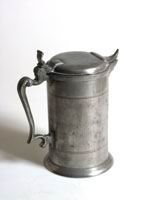Ágnes Schramm
As silver for the poor, pewter was given its name in the nineteenth century when products made from this metal were increasingly used as utilitarian as well as decorative vessels in the households of city dwellers as a substitute for noble silver kitchenware. Pewter processing is a metal inlay processing technique. Some vessels were inlayed in one piece (trays, plates, bowls and glasses) while others were joined in parts (candle holders, bottles, jugs, tin pots and tin goblets). Later, in Baroque times, smaller decorative figural or plant decorations were added. The pewter craft started to become established on the current territory of Slovakia after the discovery of pewter deposits in nearby Czech Rudohorie (near the city of Slavkov) in the tenth century. Most was brought from Silesia in the fifteenth century, and this peaked in the seventeenth and eighteenth centuries. The most significant centres for pewter guilds were Bratislava, Košice and Levoča, but Austrian, Czech and German imports from workshops in Vienna, Salzburg, Pilsner, Prague and Nuremberg were also common. The most magnificent products of pewter masters were giant trays and jugs, which were made to order for various guilds and town halls as gifts and celebrative objects. Historically, the oldest and probably most widespread articles were pewter vessels for food and drink. Due to changes in social conventions and historic periods, cutlery and kitchenware became more sophisticated and common as time passed. Plates, trays, bowls, vessels and cups for serving and consuming food as well as scoops and spoons were made in pewter workshops. For centuries, large and small jugs and goblets were offered by pewter masters in numerous variations. The latest products were small jugs and cups for coffee and chocolate as these delicacies became imported to Europe more frequently. The production of utilitarian as well as decorative pewter objects also continued to flourish in the first half of the nineteenth century. The shapes were simple, sober and of high craft quality. There was a change in the second half of the nineteenth century where, in connection with the historical influence, pewter vessels were more decorated than before but, as a result of increasing industrial production, the pewter craft significantly reduced in quality and due to a lack of interest from consumers became virtually extinct.
